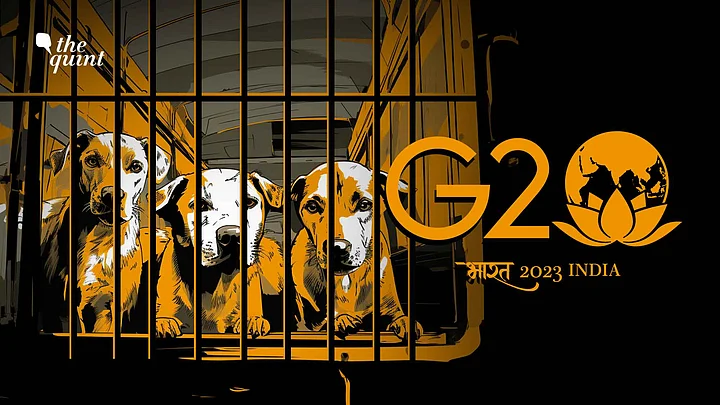Ahead of the G20 Summit, footage of the recent stray dog pick-up drive in New Delhi has been circulating on social media for the past few days.
Seemingly untrained workers are seen using metal wires and nooses to lift dogs up off the ground and huddle them into vehicles. Dogs are clearly uncomfortably bound in ropes and yelping in pain, shocked, and confused by their ordeal and unfamiliar surroundings.
Delhi-based animal rights groups have reported that even harmless, vaccinated, and senior dogs have been picked up, and in at least one case, a lactating mother separated from her pups.
Sanitising a city of its poverty and more unseemly elements is not a new phenomenon across the world. However, the manner of implementation of the present spate of removals should be a cause for public scrutiny.
ABC: What the Law Says
The Animal Birth Control Rules (ABC Rules) introduced in March 2023 take two key policy positions, on the touchstone of both of which the conduct of this drive should be examined on.
First, the rules elevate stray animals to the status of ‘community animals’. In introducing this simple change of terms, the law implicitly recognises that strays are no more seen as a ‘problem’ to be brushed under the carpet and eliminated, but as beings, the community is collectively responsible for. The rules are accordingly structured around this understanding.
Second, the rules also clearly adopt the globally accepted position that as a humane society, targeted birth control, and not indiscriminate removal, is the only ethical approach to reducing stray animal numbers.
However, as with other instances of addressing animal rights issues, the rules are a far cry from reality. For instance, strays can be captured only for two purposes, generally, to control excess animal population in specific areas through animal birth control programs, or in response to specific complaints about bites from suspected rabid dogs. After a minimum of four days of post-operative care post sterilisation, they are required to be relocated to the localities they were picked up from.
Therefore, the rules envisage only a limited holding of animals, for sterilisation, immunisation, or observation and treatment for a disease, and a prompt release thereafter. A mass and untargeted beautification drive, with spots selected for proximity to gatherings and events and not due to any history of stray dog population increase or prior incidence of bites in the area, would not qualify as adequate grounds under the rules.
The use of tongs or wires for catching dogs is explicitly prohibited.
Capture teams are also required to have personnel trained in humanely capturing stray dogs and a representative of the animal welfare organisation accompanying them. The rules also mandate public notices in those areas and the use of humane methods such as nets or hand catching
Further, the capture of animals has to have regard to the capacity of shelters. Inside those shelters, there must be adequate provision for food, water, medical care, ventilation, natural lighting, space for movement, and cleanliness. From the state of animal shelters across the country in the public domain, most of these rules are likely not implemented adequately.
It is Our Collective Responsibility
It is increasingly clear today that dealing with the community animal population and addressing conflicts in urban centres requires a long-term ABC agenda. After generations of neglect, abandonment, and human encroachment of their habitats, community animal populations in cities cannot be wished away, and nor should they be.
A commitment to reducing their numbers can coexist with a recognition of their role as friendly companions on our streets, watchful guardians of our neighbourhoods, and intelligent animal life in our dull concrete jungles. Sensitising vulnerable groups such as senior citizens and children to stray behaviour, teaching necessary precautions, promoting interactions with local strays in controlled environments to allay fears, and setting up designated feeding spots in all neighbourhoods may help address conflicts further.
Removal of stray dogs en masse has proved to be an ineffective strategy because it is blind to the territorial nature of dogs, thereby causing no reduction in stray populations.
The resulting trauma from the capture methods seen in the videos and their disorientation from relocation to unfamiliar surroundings where they do not know where to forage for food and water can only make them more defensive. This can give rise to conflict with local residents and other dogs.
As a community with a conscience, we owe a collective responsibility of care to all animals, whether they are pets or strays. Controlling stray populations can be better achieved by expanding the scope of animal birth control programs, improving basic provisions, veterinarian care, and spaces at local shelters, and investing in training and equipping municipal personnel involved in capture and release.
Even in anticipation of major gatherings, there is no purpose being served by the capture of sterilised, immunised, mothers and senior dogs, or the overwhelming majority of animals who are docile and friendly.
For the capture of any animals for sterilisation, immunisation, or suspected rabid animals on the basis of verifiable and bona fide complaints, municipal authorities should commit to close oversight of capture teams and collaboration with NGOs and local animal feeders to capture animals with as less stress and discomfort as possible.
The coming summit is an important opportunity for India to showcase its prowess as a moonfaring nation, a digital powerhouse, and a rising economic and strategic power.
By choosing compassion and care for all beings, a critical appraisal of our present progress, and abjuring short-termism, India can set a worthy example to resolve the pressing global challenges of today.
(Aman Borthakur is a public policy lawyer based in Mumbai and a graduate of NLSIU Bangalore. This is an opinion piece and the views expressed above are the author’s own. The Quint neither endorses nor is responsible for the same.)
